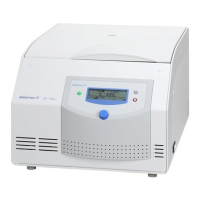Pos: 26 /100 Sig ma/100 BA Zentrif ugen Sigma (S tandardmod ule)/020 Aufbau und Wirkungsw eise/020-0 020-0020-001 0 Drehzahl, Ra dius, Relative Ze ntrifugalbeschl eunigung @ 2 6\mod_14053 18988082_68.docx @ 191849 @ 4 @ 1
→
2.2.2.1 Speed, radius, and relative centrifugal force
The acceleration g, which the samples are subject to, can be increased by
increasing the radius in the rotor chamber and by increasing the speed.
These three parameters are interdependent and linked with each other via
the following formula:
Relative centrifugal force RCF = 11.18 x 10
-6
x r x n
2
r = radius in cm
n = speed in rpm
RCF without any dimension
If two values are entered, the third value is determined by way of the stated
formula. If, afterwards, the speed or the radius is changed, the resulting
relative centrifugal force will be recalculated automatically by the control
unit. If the RCF is changed, the speed will be adapted while the specified
radius is maintained.
The speed-gravitational-field-diagram provides an overview of the
relationship between speed, radius, and RCF (see chapter 11.2 - "Speed-
gravitational-field-diagram").
Pos: 27 /010 Univers almodule/ Leerzeile @ 0\mod_120 2116244500_ 0.docx @ 11 4 @ @ 1
Pos: 28 /100 Sig ma/100 BA Zentrif ugen Sigma (S tandardmod ule)/020 Aufbau und Wirkungsw eise/020-0 020-0020-002 0 Dichte @ 26\mo d_1405318 989359_68.docx @ 191863 @ 4 @ 1
→
2.2.2.2 Density
The laboratory centrifuge is suitable for the separation of constituents of
different densities in mixtures with a maximum density of 1.2 g/cm
3
. All
information concerning the speed of rotors and accessories refers to liquids
with a density corresponding to this specification. If the density is above this
value, the maximum permissible speed of the centrifuge must be reduced
based on the following formula:
n = n
max
x
√
(1.2/𝜌)
𝜌 = density in g/cm
3
Pos: 29 /010 Univers almodule/ Absc hnittswechsel @ 0\mod_12021 24514062_0.docx @ 418 @ @ 1
Pos: 30 /010 Univers almodule/ Seitenwec hsel @ 0\m od_1202116244 312_0.docx @ 105 @ @ 1

